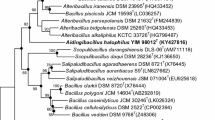Abstract
Acidobacterium is proposed as a new genus for the acidophilic, chemoorganotrophic bacteria containing menaquinone isolated from acidic mineral environments.Acidobacterium capsulatum is proposed for the singleAcidobacterium species which consists of eight strains (Biogroup 5). The members of this species are gram-negative, aerobic, mesophilic, non-spore-forming, capsulated, saccharolytic, and rod-shaped bacteria. They are motile by peritrichous flagella. They can grow between pH 3.0 and 6.0, but not at pH 6.5. They give positive results in tests for esculin hydrolysis, catalase, and β-galactosidase. Oxidase and urease are negative. They can use glucose, cellobiose, starch, maltose, or β-gentiobiose as a sole carbon source, but cannot use elemental sulfur and ferrous iron as an energy source. The DNA base composition is 59.7–60.8 guanine plus cytosine (G+C) mol%. The major isoprenoid quinone is menaquinone with eight isoprene units (MK-8). The major fatty acid is 13-methyltetradecanoic acid. DNA relatedness between this species and the species ofAcidiphilium, Acidomonas, andDeinobacter was 18 to 2%. From phenotypic and chemotaxonomic characters, these member do not belong to any known taxa of gram-negative bacteria. A culture of the type strain (strain 161) has been deposited in the Japan Collection of Microorganisms as JCM 7670.
Similar content being viewed by others
Literature Cited
Christensen WB (1946) Urea decomposition as means of differentiatingProteus andParacolon cultures from each other. J Bacteriol 52:461–466
Collins MD, Jones D (1981) Distribution of isoprenoid quinone structural types in bacteria and their taxonomic implications. Microbiol Rev 45:315–354
Collins MD, Langworthy TA (1983) Respiratory quinone composition of some acidophilic bacteria. Syst Appl Microbiol 4:295–304
Dugan PR, Macmillan CB, Pfister RM (1970) Aerobic heterotrophic bacteria indigenous to pH 2.8 acid mine water: microscopic examination of acid streamers. J Bacteriol 101:973–981
Dugan PR, Macmillan CB, Pfister RM (1970) Aerobic heterotrophic bacteria indigenous to pH 2.8 acid mine water: predominant slime-producing bacteria in acid streamers. J Bacteriol 101:982–988
Harrison AP Jr (1981)Acidiphilium cryptum gen. nov., sp. nov.: heterotrophic bacteria from acidic mineral environments. Int J Syst Bacteriol 31:327–332
Harrison AP Jr, Jarvis BW, Johnson JL (1980) Heterotrophic bacteria from cultures of autotrophicThiobacillus ferrooxidans. J Bacteriol 143:448–454
Ikemoto S, Kuraishi H, Komagata K, Azuma R, Suto T, Murooka H (1978) Cellular fatty acid composition inPseudomonas species. J Gen Appl Microbiol 24:199–213
James TS, Bryant MP, Pfennig N, Holt JG (eds) (1989) Bergey's manual of systematic bacteriology, vol. 3. Baltimore: Williams and Wilkins, pp 1601–2251
Kishimoto N, Tano T (1987) Acidophilic heterotrophic bacteria isolated from acidic mine drainage, sewage, and soils. J Gen Appl Microbiol 33:11–25
Kosako Y, Sakazaki R, Yoshizaki E (1984)Yokenella regensburgei sp. nov, gen. nov., a new genus and species in the familyEnterobacteriaceae. Jpn J Med Sci Biol 37:117–124
Krieg NR, Holt JG (eds) (1984) Bergey's manual of systematic bacteriology, vol. 1, Baltimore: Williams and Wilkins, pp 1–964
Lobos JH, Chisolm TE, Bopp LH, Holmes DS (1986)Acidiphilium organovorum sp. nov., an acidophilic heterotroph isolated from aThiobacillus ferrooxidans culture. Int J Syst Bacteriol 36:139–144
Oyaizu H, Stackebrandt E, Schleifer KH, Ludwig W, Pohla H, Ito H, Hirata A, Oyaizu Y, Komagata K (1987) A radiation-resistant rod-shaped bacterium,Deinobacter grandis gen. nov., sp. nov., with peptidoglycan containing ornithine. Int J Syst Bacteriol 37:62–67
Suzuki K, Collins MD, Iijima E, Komagata K (1988) Chemotaxonomic characterization of a radiotolerant bacterium,Arthrobacter radiotolerans: Description ofRubrobacter radiotolerans gen. nov., comb. nov. FEMS Microbiol Lett 52:33–40
Tamaoka J, Katayama-Fujimura Y, Kuraishi H (1983) Analysis of bacterial menaquinone mixtures by high performance liquid chromatography. J Appl Microbiol 54:31–36
Urakami T, Tamaoka J, Komagata K (1989)Acidomonas gen. nov., IncorporatingAcetobacter methanolica asAcidomonas methanolica comb. nov. Int J Syst Bacteriol 39:50–55
Wichlacz PL, Unz RF (1981) Acidophilic, heterotrophic bacteria of acidic mine waters. Appl Environ Microbiol 41:1254–1261
Wichlacz PL, Unz RF, Langworthy TA (1986)Acidiphilium angustum sp. nov.,Acidiphilium facilis sp. nov., andAcidiphilium rubrum sp. nov.: acidophilic heterotrophic bacteria isolated from acidic coal mine drainage. Int J Syst Bacteriol 36:197–201
Author information
Authors and Affiliations
Rights and permissions
About this article
Cite this article
Kishimoto, N., Kosako, Y. & Tano, T. Acidobacterium capsulatum gen. nov., sp. nov.: An acidophilic chemoorganotrophic bacterium containing menaquinone from acidic mineral environment. Current Microbiology 22, 1–7 (1991). https://doi.org/10.1007/BF02106205
Issue Date:
DOI: https://doi.org/10.1007/BF02106205



